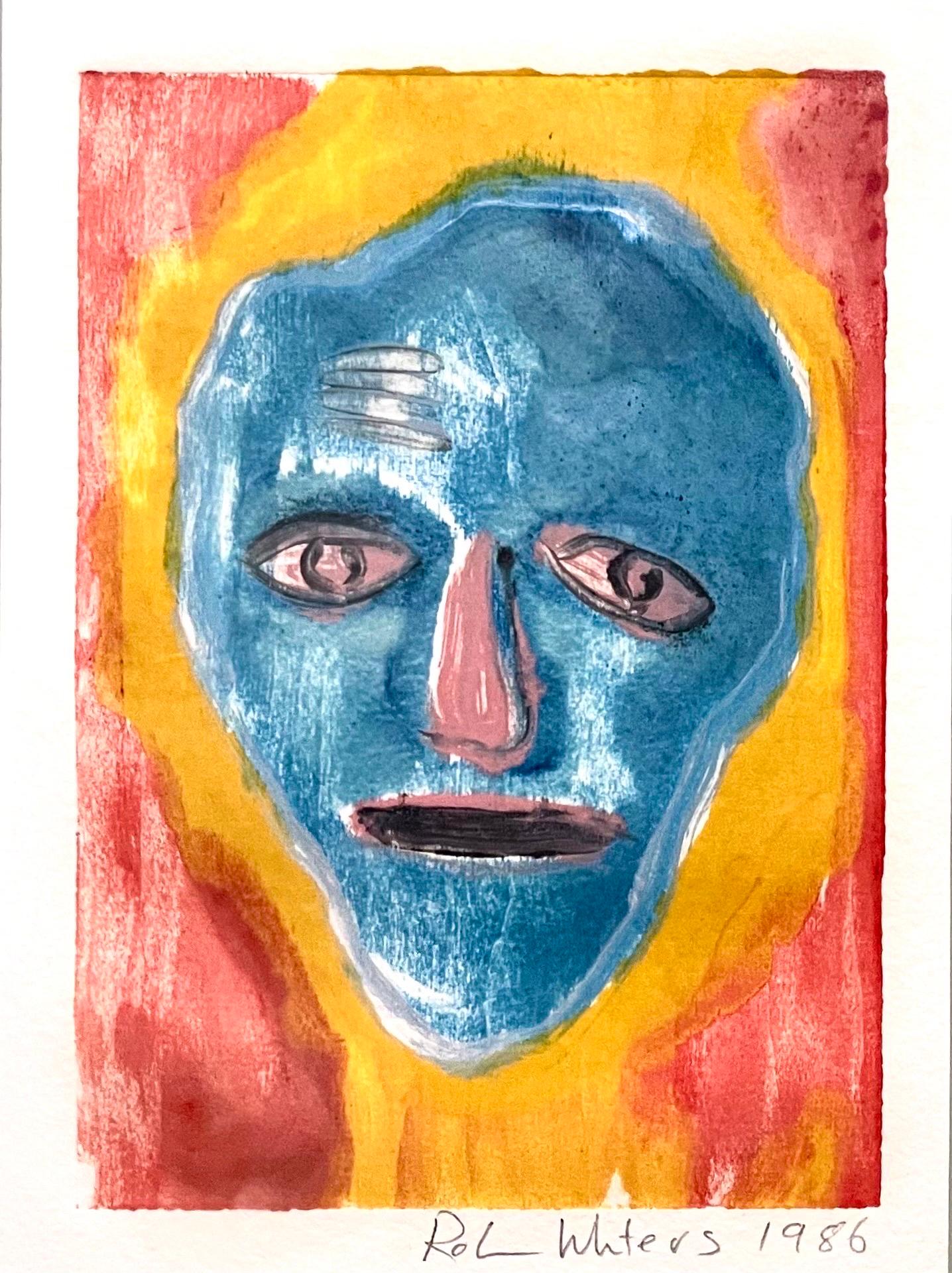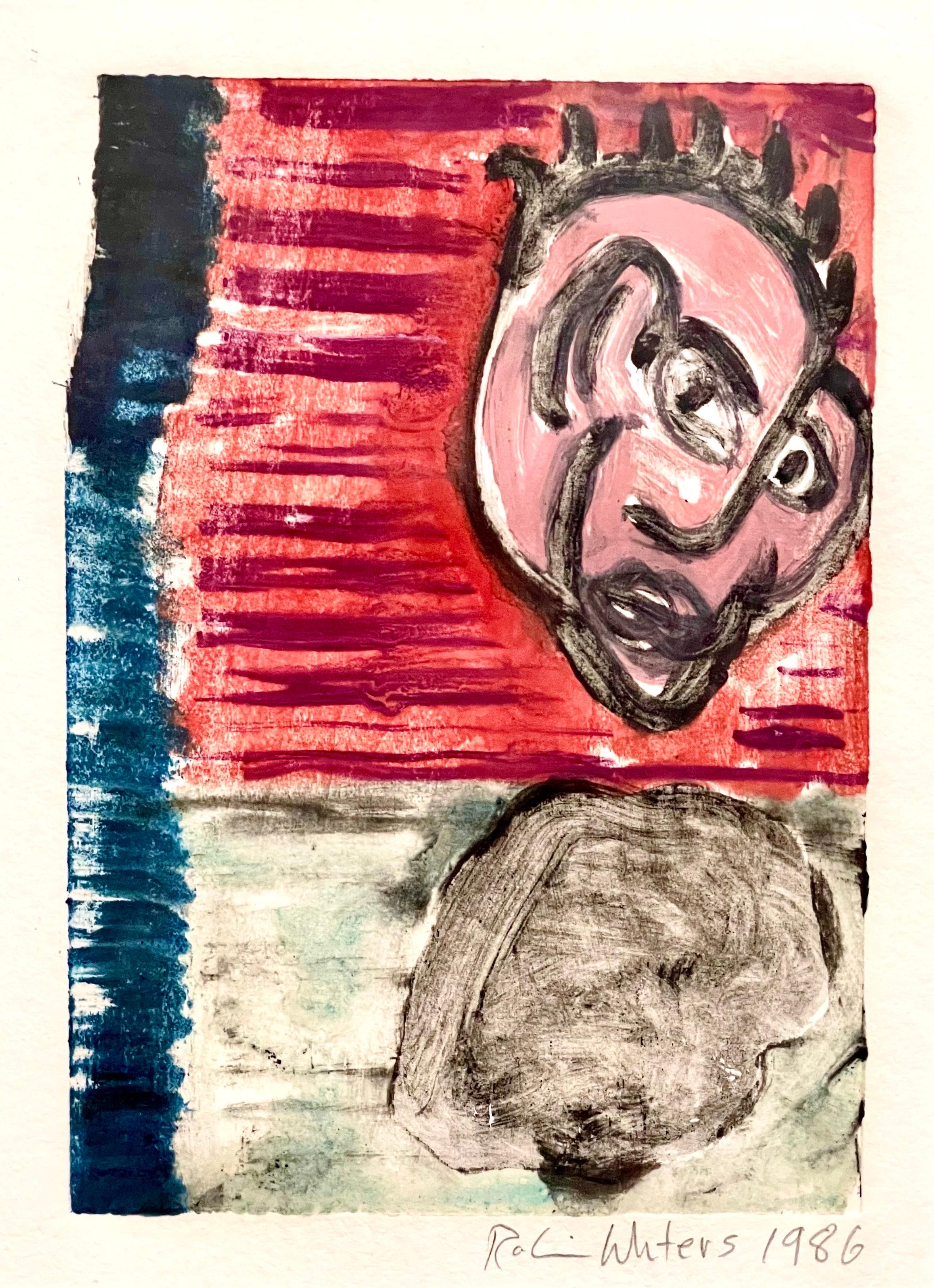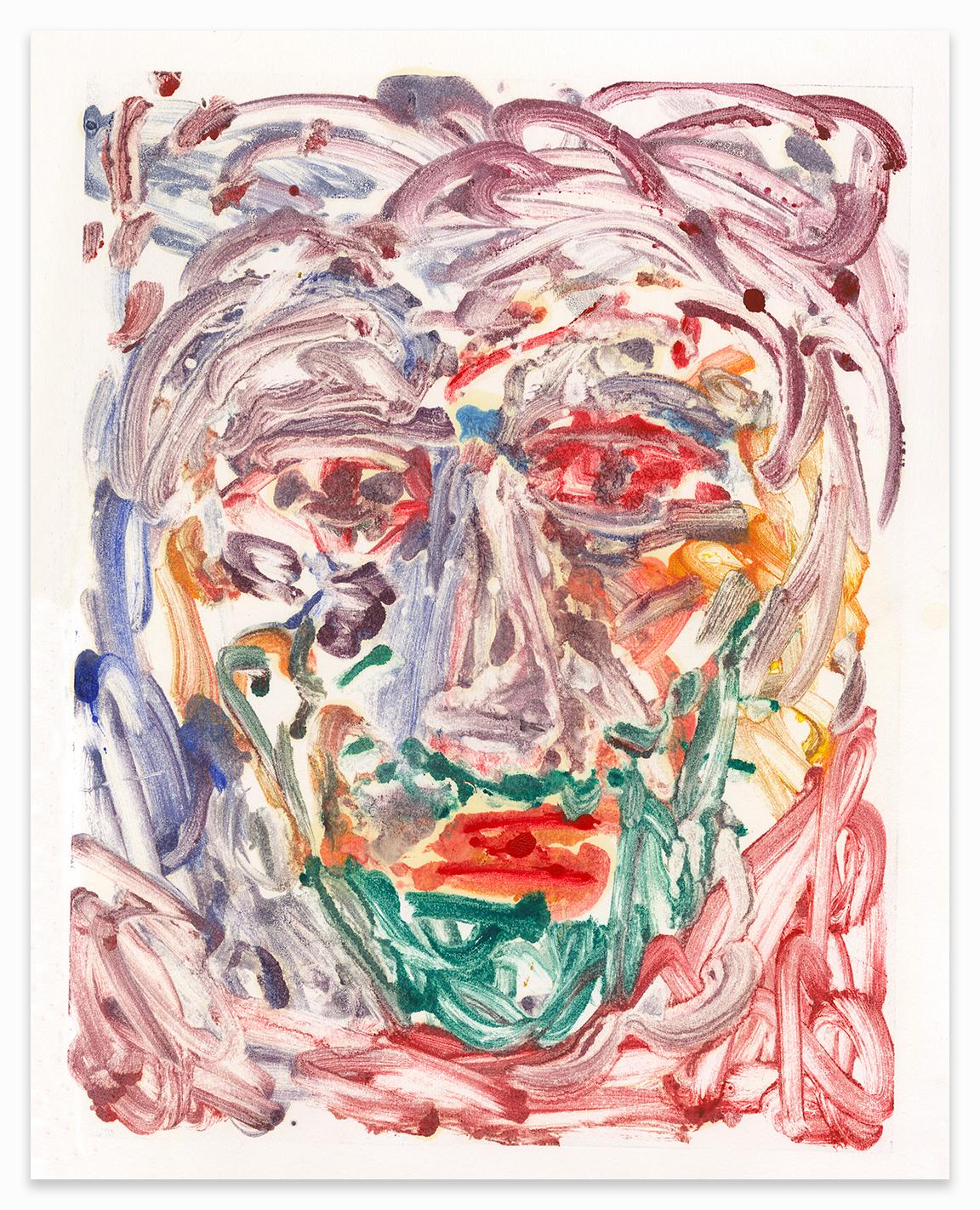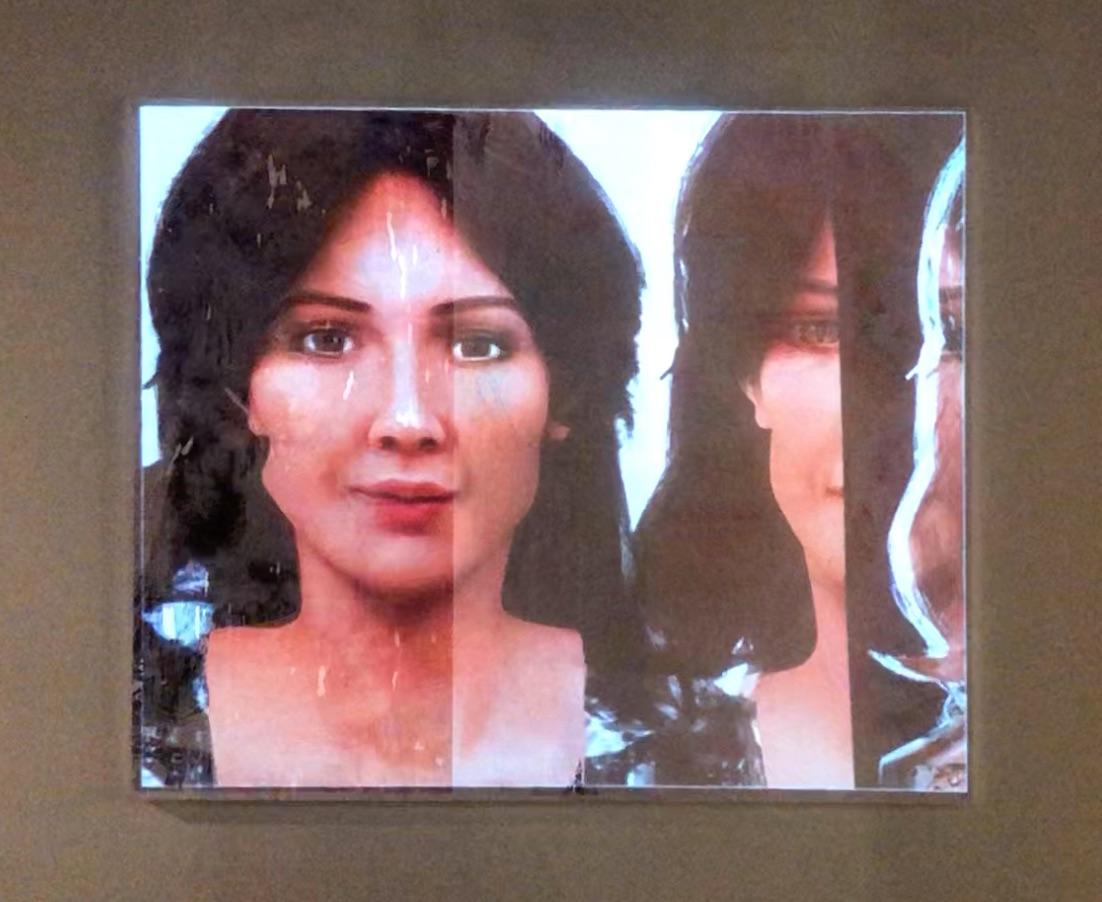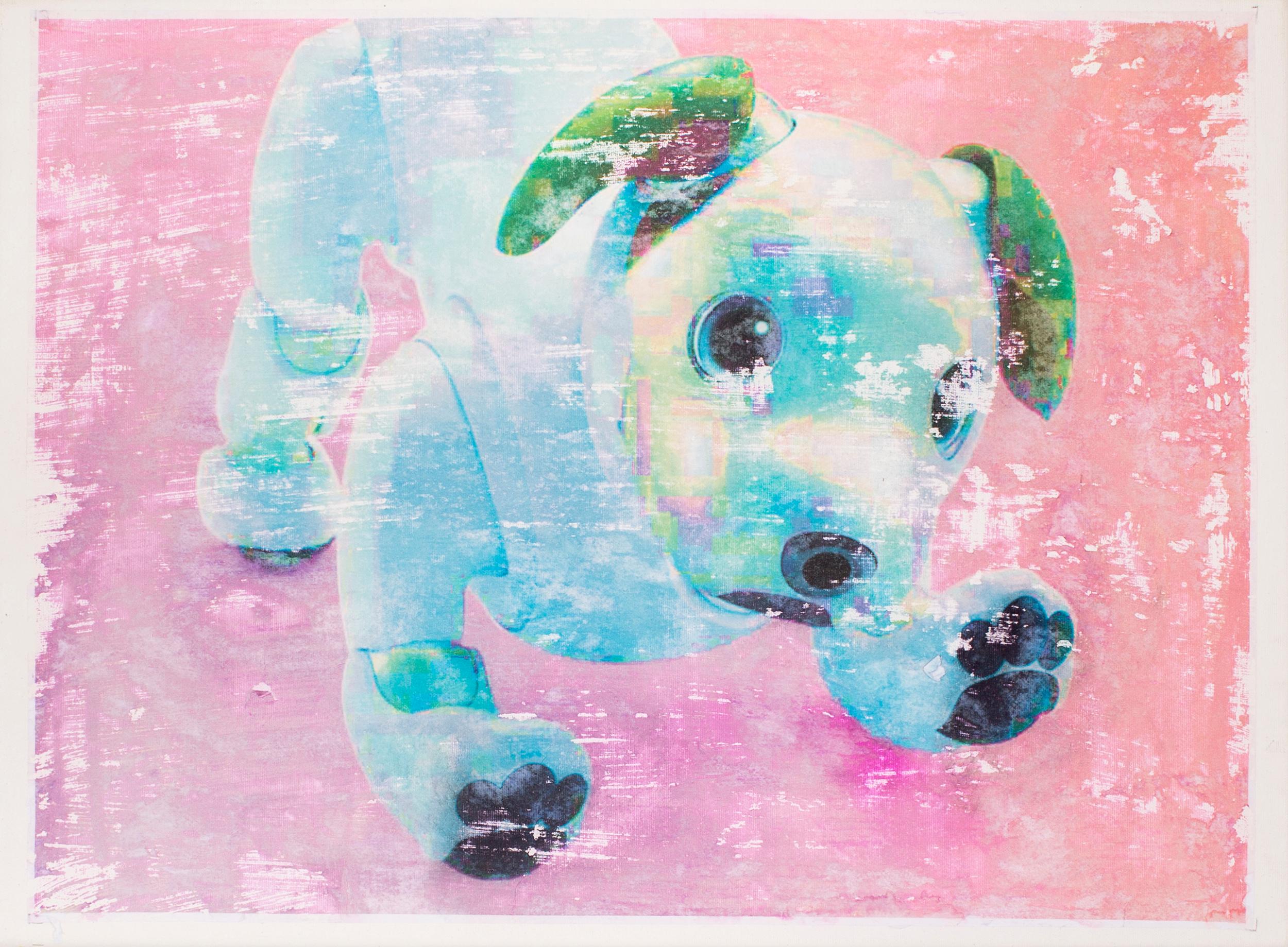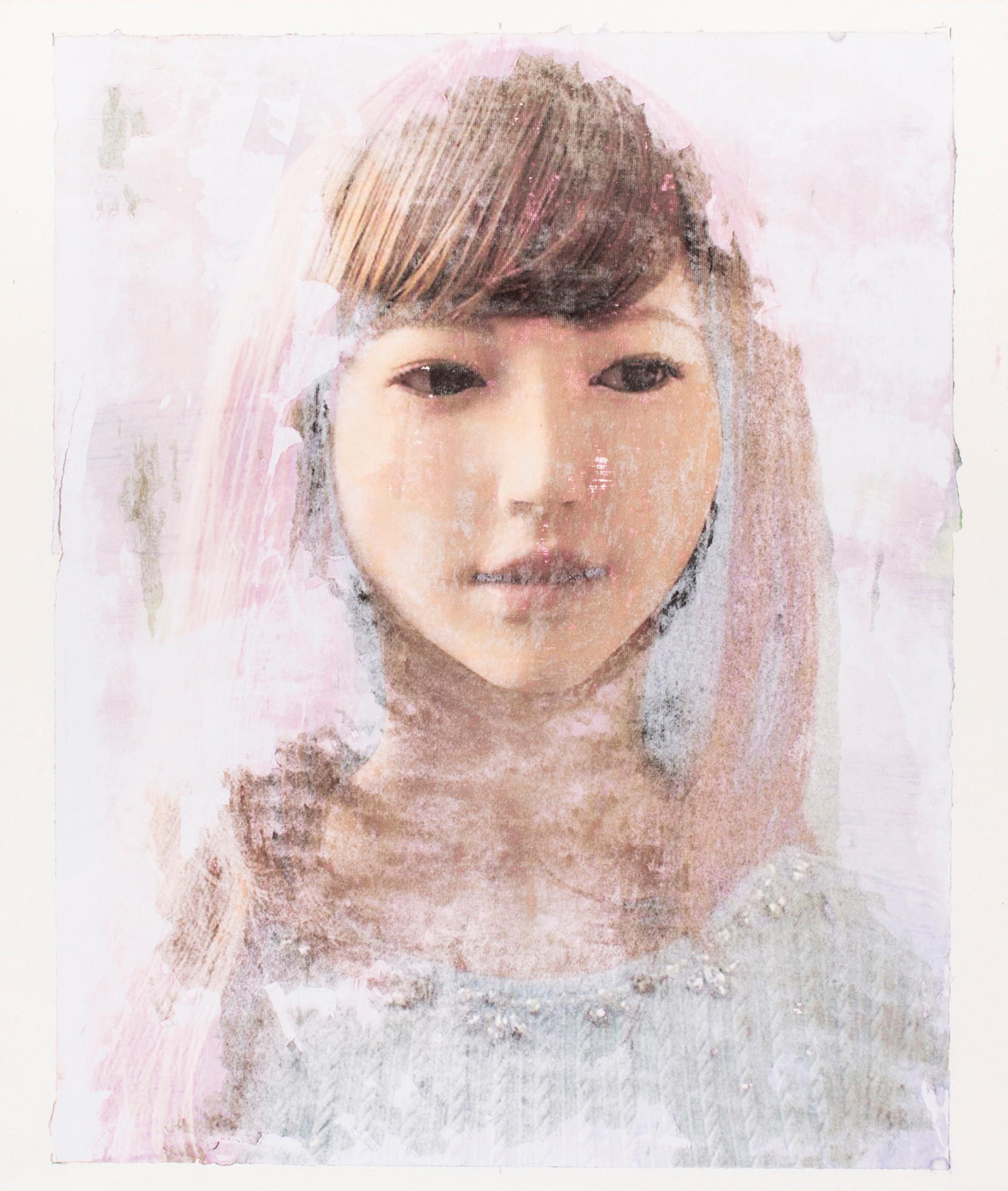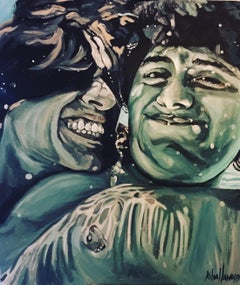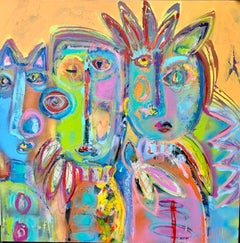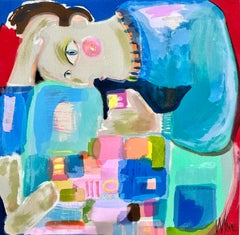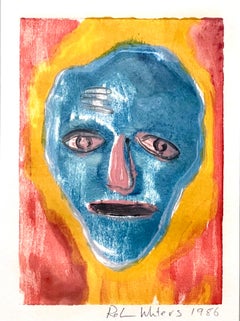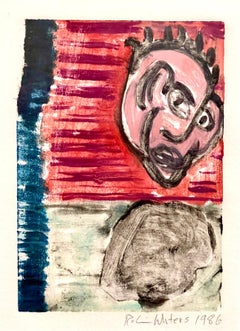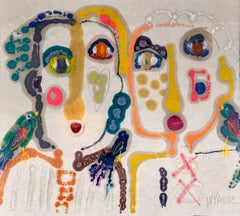
Bird People, Original Contemporary Figurative Painting on Canvas
View Similar Items
Want more images or videos?
Request additional images or videos from the seller
1 of 8
Wyanne ThompsonBird People, Original Contemporary Figurative Painting on Canvas2023
2023
About the Item
- Creator:Wyanne Thompson
- Creation Year:2023
- Dimensions:Height: 16.5 in (41.91 cm)Width: 15.5 in (39.37 cm)Depth: 1 in (2.54 cm)
- Medium:
- Movement & Style:
- Period:
- Condition:
- Gallery Location:Boston, MA
- Reference Number:Seller: 1062381stDibs: LU1634212986182
About the Seller
5.0
Gold Seller
These expertly vetted sellers are highly rated and consistently exceed customer expectations.
Established in 2009
1stDibs seller since 2021
75 sales on 1stDibs
Typical response time: 2 hours
More From This SellerView All
- LoveLocated in Boston, MAArtist Commentary: This piece is part of a series called The Four Elements, and the idea was to portrait human emotions and aesthetics related to one of the four elements in this case Water.. And is called love because is a mother with her son. Keywords: Figurative, expressionist, green, smile, happy Artist Biography: Fine Artist, muralist, illustrator and art teacher. I was born in Santo Domingo, Dominican Republic in 1972. I studied Fine Arts and Illustration at Altos De Chavón School Of Design (1992) and also got a bachelor degree in Fine Arts and Illustration at Parsons School Of Design (1994), NY. I’ve participated in several collective art shows and also five solo shows at Santo Domingo, Barcelona and Miami (Art Basel 2017); I’ve been working with others fellow artists doing urban art at the streets of several cities an small communities in the Dominican Republic since 2012, where I’ve done about 35 murals, I participated as international guest artist at the Art festival “Voz de Vida” at the city of Pasto, Colombia, I was a resident artist at Graniti Murales at Sicily, Italy, and painted with “transitando” at Madrid, Spain. In august 2018 I was invited to participate at Beyond Walls Lynn, in Boston, MA, and in 2020 I painted at Savannah, Georgia invited by The Stables Art...Category
21st Century and Contemporary Abstract Figurative Paintings
MaterialsCanvas, Acrylic
$2,000 - Up To No Good Gang, Original Signed Bold Contemporary Abstract Figure PaintingLocated in Boston, MAUp To No Good Gang, Original Signed Bold Contemporary Abstract Figure Painting 36x36x1 (HxWxD), Acrylic Paint Reminiscent of Pablo Picasso's cubist portraits, this painting by Wyanne Thompson...Category
21st Century and Contemporary Abstract Abstract Paintings
MaterialsAcrylic
- The Puzzle, Original Contemporary Figurative Painting on CanvasLocated in Boston, MAThe Puzzle, Original Contemporary Figurative Painting on Canvas 36x36 (HxW), Acrylic Paint This fun, colorful, inverted abstract figura...Category
21st Century and Contemporary Abstract Figurative Paintings
MaterialsAcrylic
- Lightness of Being, Original Mixed Media Horse PaintingBy Dara DanielLocated in Boston, MALightness of Being 36.0 x 24.0 x 1.5, 10.0 lbs Acrylic Hand signed by artist Artist's Commentary: My first 2022 painting titled 'The Lightness of Being' indicates a change in m...Category
21st Century and Contemporary Abstract Expressionist Figurative Paintings
MaterialsAcrylic
- The Light That Won't Turn OffLocated in Boston, MAArtist Commentary: This piece is part of a series I've been working on about my recent trip visiting family in the Philippines. The paintings all contain layered elements of plants, ...Category
21st Century and Contemporary Abstract Abstract Paintings
MaterialsAcrylic, Panel
- Dreaming of Egypt, Original Abstract Painting, 2021By Sally SmithLocated in Boston, MAArtist Commentary: This semi-abstract painting combines suggestions of canopies, windows, pyramids, figures, and patterns to evoke the mystery of travel. Keywords: semi-abstract int...Category
21st Century and Contemporary Abstract Abstract Paintings
MaterialsLinen, Oil
You May Also Like
- Conceptual Pop Art Color Oil Monotype Painting Abstract Figure Robin WintersBy Robin WintersLocated in Surfside, FLRobin Winters (American, born 1950), Untitled (Red Face) from "Cherry Block Series" 1986, monotype, pencil signed and dated lower right, plate: 6"h x 8.5"w, overall (with frame): 22.25"h x 18.25"w. Provenance: Property from a Private Collection, San Francisco. Winters was invited to make monotypes at Experimental Workshop in San Francisco, (they printed Richard Bosman, Sam Francis, Claire Falkenstein, Deborah Oropallo and Kenneth Noland and many more greats). Winters chose to paint on wood blocks rather than the more usual metal plates in order to capture the organic quality of the natural material. He exploited a salient characteristic of the monoprint in Ghost Story by adding new painted elements onto the increasingly faint ghost images that result from successive impressions from a single block. In so doing he achieved the effect of transparent layers of color and shadow imagery. Winters's brightly-colored monotypes portray an array of figures and landscapes (and an occasional still-life) that, although can be seen in the context of a general trend away from abstraction that has marked the 1980s, defy strict stylistic categorization. They are neither realistic nor abstract, psychological self-examinations nor narrative fictions, but they contain elements of all of these approaches. Like Jonathan Borofsky, Winters derives much of his subject matter from dreams, believing that through his private fears and obsessions he can touch similar emotions in others. Although at first glance Winters's images look as if they could have been made by a child, closer attention reveals sly art historical references to Jackson Pollock and Pattern Painting (the drip and splatter backgrounds), Mark Rothko (the three-part horizontal compositions) and Minimalism (the gridded Cherry Block Series: Bread Beat). Robin Winters (born 1950 in Benicia, California) is an American conceptual, multi-disciplinary, artist and teacher based in New York. Winters is known for creating solo exhibitions containing an interactive durational performance component to his installations, sometimes lasting up to two months. Winters first emerged in the burgeoning Soho NYC art scene of the 1970s. An early practitioner of the Relational Aesthetics (social interaction as an art medium) Winters also created in works through sculpture, installation, performance, painting, drawing and prints. His art maintains a whimsical spirit, and he often returns to ongoing themes involving faces, boats, cars, bottles, hats and jesters or fools. Winters has incorporated such devices as blind dates, double dates, dinners, fortune telling, and free consultation in his performances. Throughout his career he has engaged in a wide variety of media, such as performance art, film, video, writing prose and poetry, photography, installation art, printmaking, drawing, painting, ceramic sculpture, bronze sculpture, and glassblowing. Winters was born in Benicia, California in 1950 to lawyer parents. As a child his hobby was collecting glass bottles found on the beach and under old buildings, which would later influence him as an artist. In 1968, Winters had his first durational performance, entitled Norman Thomas Travelling Museum. The artist drove a Volkswagen bus decorated in collage, many of the images relating to current events and politics. Inside was what the artist described as a “reliquary” containing many objects, including a bottle collection. Winters took the van to shopping centers and even as far as Mexico. That same year, Winters opted not to register for the military draft. Although he was deemed fit to serve, Winters refused. In 1975 the resulting legal proceedings finally came to a close after it was proven that the artist had been harassed by the local draft board. In his teens and early twenties, Winters became acquainted with several local artists who helped shape his aesthetic, most notably Manuel Neri and Robert Arneson. By the early 1970s, Winters was studying at the San Francisco Art Institute (SFAI) and had relocated to San Francisco. At this time Winters became friends with the Bay Area conceptual artists Terry Fox and Howard Fried, and participated in several of Fried's performance works. In 1972 Winters was accepted into the Whitney Independent Study Program in New York City. After coming to New York City, Winters helped support himself by working for various artists, among them the performance artist Joan Jonas and sculptor Donald Judd. In 1974, Winters performed The Secret Life of Bob-E or Bob-E Behind the Veil eight hours a day, five days a week for a month in his studio apartment. Behind a one-way mirror the audience could watch Winters play the character of Bob-E, whose goal was to make a monument for everyone in the world in the form of blue and yellow rubber top hats. By the end of the month the artist had constructed 262 hats. The following year, Winters was invited to take part in the Whitney Museum's 1975 Biennial Exhibition. Entitled W.B. Bearman Bags a Job or Diary of a Dreamer. Winters was traveling in 1975 and 1976, spending time in North Africa and in Europe. At a time when most young American artists were unaware of their European counterparts, Winters met and was influenced by such artists as Sigmar Polke and Marcel Broodthaers (with whom Winters worked on an installation) and also had a one-person exhibition, at the Konrad Fischer Gallery in Dusseldorf. Returning to New York in 1976, Winters teamed up with a group of artists to form Collaborative Projects (Colab), a rather anarchistic organization dedicated to artistic collaboration and the creation of art that questioned social values.. Also in 1976, Winters formed the partnership “X&Y” with fellow artist Coleen Fitzgibbon that would last two years. Together they performed a series of shows in the Netherlands, most notably a show entitled Take the Money and Run. Performed at De Appel in Amsterdam, the show involved the artists robbing their audience. The following day the audience was given an apology, as well as the opportunity to retrieve any valuables and participate in a lottery to win the artists’ services. They also made a Super 8 film in NY called Rich-Poor, in which they asked people on the streets their thoughts on the rich and poor. In 1980 Winters participated in The Real Estate Show and in Absurdities at ABC No Rio. That same year he and artists Peter Fend, Coleen Fitzgibbon, Peter Nadin, Jenny Holzer, and Richard Prince also formed The Offices of Fend, Fitzgibbon, Holzer, Nadin, Prince & Winters. This short-lived collective was based out of an office on lower Broadway and offered “Practical Esthetic Services Adaptable to Client Situation”, as stated on their business card. Their goal was to offer their art as “socially helpful work for hire”. In June of that year Winters participated in The Times Square Show, Colab's most well-known exhibition. The month-long show took place in a four floor building on West 41st Street and was densely packed with art. To cap off a busy year, Winters also became one of the first artists to join the Mary Boone Gallery, showing a successful solo exhibition in 1981. His work was shown in the New York/New Wave show in 1981 at MoMA PS1 along with Jean-Michel Basquiat, Roberta Bayley, William S. Burroughs, David Byrne, Sarah Charlesworth, Larry Clark, Crash (John Matos), Ronnie Cutrone, Brian Eno, Peter Fend, Nan Goldin, Keith Haring, Ray Johnson, Joseph Kosuth, Marcus Leatherdale, Christopher Makos, Robert Mapplethorpe, Elaine Mayes, Frank Moore, Kenny Scharf and others. In 1982, Winters had his first solo exhibition in Los Angeles at the Richard Kuhlenschmidt Gallery. At the Mo David Gallery in 1984, Winters created an installation piece that consisted of a floor of plaster tiles. Underneath each tile, hidden from view, was a drawing. He designed the stage sets for the musician Nico, and assisted French artist Orlan, American artist Stuart Sherman, and American poet Gregory Corso. Two years later Winters was invited to take part in Chambres d’Amis (In Ghent there is Always a Free Room for Albrecht Durer) in Ghent, Belgium. In it, 51 artists created installations in 50 different sites, mostly private homes. Winters chose the home of a local art historian. The artist made 90 drawings based on images found in the large collection of art books in the home's library. He made two copies of each drawing and placed the originals in the books themselves. One set of copies was exhibited in the sponsoring museum, Museum van Hedendaagse, as "The Ghent Drawings". The drawings were also on display at Winters’ solo exhibition at Luhring Augustine & Hodes Gallery in New York City in 1987. In 1986, Winters had a solo exhibition at Maurice Keitelman Gallery in Brussels, Belgium, and the following year a solo exhibition at the Centre Régional d'Art Contemporain Midi-Pyrénées in Toulouse, France. Also in 1986, Winters' Playroom was held at the Institute for Contemporary Art in Boston, Massachusetts. The exhibition was part of Think Tank, a retrospective of Winters' work which traveled to the Stedelijk Museum in the Netherlands, the Centre Regional d’Art Contemporain in France, and the Contemporary Arts Center in Ohio. Winters spent a month in 1989 working with students at the San Francisco Art Institute. Never having worked with ceramics, he spent the month making numerous ceramic pieces, which were then shown in the aptly named One Month in San Francisco. Other components of the piece included Winters’ childhood bottle collection and a video showing each piece in the show filmed briefly next to a ruler.[ Also that year, Robin served as a visiting artist at the Pilchuck Glass School, where he met artist John Drury, who was then working as the school's artist liaison. In the summer of 1990, Winters interviewed fellow artist Kiki Smith for her eponymous book, which was published later that year. That same year (1990), Winters was invited by the Val Saint Lambert glass factory in Belgium to create glassworks in their facility. Winters, artists John Drury and Tracy Glover...Category
1980s Pop Art Figurative Paintings
MaterialsMonoprint, Monotype
- Conceptual Pop Art Color Oil Monotype Painting Abstract Figure Robin WintersBy Robin WintersLocated in Surfside, FLRobin Winters (American, born 1950), Untitled (Red Face) from "Cherry Block Series" 1986, monotype, pencil signed and dated lower right, plate: 6"h x 8.5"w, overall (with frame): 22.25"h x 18.25"w. Provenance: Property from a Private Collection, San Francisco. Winters was invited to make monotypes at Experimental Workshop in San Francisco, (they printed Richard Bosman, Sam Francis, Claire Falkenstein, Deborah Oropallo and Kenneth Noland and many more greats). Winters chose to paint on wood blocks rather than the more usual metal plates in order to capture the organic quality of the natural material. He exploited a salient characteristic of the monoprint in Ghost Story by adding new painted elements onto the increasingly faint ghost images that result from successive impressions from a single block. In so doing he achieved the effect of transparent layers of color and shadow imagery. Winters's brightly-colored monotypes portray an array of figures and landscapes (and an occasional still-life) that, although can be seen in the context of a general trend away from abstraction that has marked the 1980s, defy strict stylistic categorization. They are neither realistic nor abstract, psychological self-examinations nor narrative fictions, but they contain elements of all of these approaches. Like Jonathan Borofsky, Winters derives much of his subject matter from dreams, believing that through his private fears and obsessions he can touch similar emotions in others. Although at first glance Winters's images look as if they could have been made by a child, closer attention reveals sly art historical references to Jackson Pollock and Pattern Painting (the drip and splatter backgrounds), Mark Rothko (the three-part horizontal compositions) and Minimalism (the gridded Cherry Block Series: Bread Beat). Robin Winters (born 1950 in Benicia, California) is an American conceptual, multi-disciplinary, artist and teacher based in New York. Winters is known for creating solo exhibitions containing an interactive durational performance component to his installations, sometimes lasting up to two months. Winters first emerged in the burgeoning Soho NYC art scene of the 1970s. An early practitioner of the Relational Aesthetics (social interaction as an art medium) Winters also created in works through sculpture, installation, performance, painting, drawing and prints. His art maintains a whimsical spirit, and he often returns to ongoing themes involving faces, boats, cars, bottles, hats and jesters or fools. Winters has incorporated such devices as blind dates, double dates, dinners, fortune telling, and free consultation in his performances. Throughout his career he has engaged in a wide variety of media, such as performance art, film, video, writing prose and poetry, photography, installation art, printmaking, drawing, painting, ceramic sculpture, bronze sculpture, and glassblowing. Winters was born in Benicia, California in 1950 to lawyer parents. As a child his hobby was collecting glass bottles found on the beach and under old buildings, which would later influence him as an artist. In 1968, Winters had his first durational performance, entitled Norman Thomas Travelling Museum. The artist drove a Volkswagen bus decorated in collage, many of the images relating to current events and politics. Inside was what the artist described as a “reliquary” containing many objects, including a bottle collection. Winters took the van to shopping centers and even as far as Mexico. That same year, Winters opted not to register for the military draft. Although he was deemed fit to serve, Winters refused. In 1975 the resulting legal proceedings finally came to a close after it was proven that the artist had been harassed by the local draft board. In his teens and early twenties, Winters became acquainted with several local artists who helped shape his aesthetic, most notably Manuel Neri and Robert Arneson. By the early 1970s, Winters was studying at the San Francisco Art Institute (SFAI) and had relocated to San Francisco. At this time Winters became friends with the Bay Area conceptual artists Terry Fox and Howard Fried, and participated in several of Fried's performance works. In 1972 Winters was accepted into the Whitney Independent Study Program in New York City. After coming to New York City, Winters helped support himself by working for various artists, among them the performance artist Joan Jonas and sculptor Donald Judd. In 1974, Winters performed The Secret Life of Bob-E or Bob-E Behind the Veil eight hours a day, five days a week for a month in his studio apartment. Behind a one-way mirror the audience could watch Winters play the character of Bob-E, whose goal was to make a monument for everyone in the world in the form of blue and yellow rubber top hats. By the end of the month the artist had constructed 262 hats. The following year, Winters was invited to take part in the Whitney Museum's 1975 Biennial Exhibition. Entitled W.B. Bearman Bags a Job or Diary of a Dreamer. Winters was traveling in 1975 and 1976, spending time in North Africa and in Europe. At a time when most young American artists were unaware of their European counterparts, Winters met and was influenced by such artists as Sigmar Polke and Marcel Broodthaers (with whom Winters worked on an installation) and also had a one-person exhibition, at the Konrad Fischer Gallery in Dusseldorf. Returning to New York in 1976, Winters teamed up with a group of artists to form Collaborative Projects (Colab), a rather anarchistic organization dedicated to artistic collaboration and the creation of art that questioned social values.. Also in 1976, Winters formed the partnership “X&Y” with fellow artist Coleen Fitzgibbon that would last two years. Together they performed a series of shows in the Netherlands, most notably a show entitled Take the Money and Run. Performed at De Appel in Amsterdam, the show involved the artists robbing their audience. The following day the audience was given an apology, as well as the opportunity to retrieve any valuables and participate in a lottery to win the artists’ services. They also made a Super 8 film in NY called Rich-Poor, in which they asked people on the streets their thoughts on the rich and poor. In 1980 Winters participated in The Real Estate Show and in Absurdities at ABC No Rio. That same year he and artists Peter Fend, Coleen Fitzgibbon, Peter Nadin, Jenny Holzer, and Richard Prince also formed The Offices of Fend, Fitzgibbon, Holzer, Nadin, Prince & Winters. This short-lived collective was based out of an office on lower Broadway and offered “Practical Esthetic Services Adaptable to Client Situation”, as stated on their business card. Their goal was to offer their art as “socially helpful work for hire”. In June of that year Winters participated in The Times Square Show, Colab's most well-known exhibition. The month-long show took place in a four floor building on West 41st Street and was densely packed with art. To cap off a busy year, Winters also became one of the first artists to join the Mary Boone Gallery, showing a successful solo exhibition in 1981. His work was shown in the New York/New Wave show in 1981 at MoMA PS1 along with Jean-Michel Basquiat, Roberta Bayley, William S. Burroughs, David Byrne, Sarah Charlesworth, Larry Clark, Crash (John Matos), Ronnie Cutrone, Brian Eno, Peter Fend, Nan Goldin, Keith Haring, Ray Johnson, Joseph Kosuth, Marcus Leatherdale, Christopher Makos, Robert Mapplethorpe, Elaine Mayes, Frank Moore, Kenny Scharf and others. In 1982, Winters had his first solo exhibition in Los Angeles at the Richard Kuhlenschmidt Gallery. At the Mo David Gallery in 1984, Winters created an installation piece that consisted of a floor of plaster tiles. Underneath each tile, hidden from view, was a drawing. He designed the stage sets for the musician Nico, and assisted French artist Orlan, American artist Stuart Sherman, and American poet Gregory Corso. Two years later Winters was invited to take part in Chambres d’Amis (In Ghent there is Always a Free Room for Albrecht Durer) in Ghent, Belgium. In it, 51 artists created installations in 50 different sites, mostly private homes. Winters chose the home of a local art historian. The artist made 90 drawings based on images found in the large collection of art books in the home's library. He made two copies of each drawing and placed the originals in the books themselves. One set of copies was exhibited in the sponsoring museum, Museum van Hedendaagse, as "The Ghent Drawings". The drawings were also on display at Winters’ solo exhibition at Luhring Augustine & Hodes Gallery in New York City in 1987. In 1986, Winters had a solo exhibition at Maurice Keitelman Gallery in Brussels, Belgium, and the following year a solo exhibition at the Centre Régional d'Art Contemporain Midi-Pyrénées in Toulouse, France. Also in 1986, Winters' Playroom was held at the Institute for Contemporary Art in Boston, Massachusetts. The exhibition was part of Think Tank, a retrospective of Winters' work which traveled to the Stedelijk Museum in the Netherlands, the Centre Regional d’Art Contemporain in France, and the Contemporary Arts Center in Ohio. Winters spent a month in 1989 working with students at the San Francisco Art Institute. Never having worked with ceramics, he spent the month making numerous ceramic pieces, which were then shown in the aptly named One Month in San Francisco. Other components of the piece included Winters’ childhood bottle collection and a video showing each piece in the show filmed briefly next to a ruler.[ Also that year, Robin served as a visiting artist at the Pilchuck Glass School, where he met artist John Drury, who was then working as the school's artist liaison. In the summer of 1990, Winters interviewed fellow artist Kiki Smith for her eponymous book, which was published later that year. That same year (1990), Winters was invited by the Val Saint Lambert glass factory in Belgium to create glassworks in their facility. Winters, artists John Drury and Tracy Glover...Category
1980s Pop Art Figurative Paintings
MaterialsMonoprint, Monotype
- FACE III - monotypeLocated in East Patchogue, NYOriginal Monotype, ink and oil on paper, signed by the artist Unique piece. Samuel Bloch paints canvases on the frontier of abstraction that give free re...Category
2010s Contemporary Figurative Paintings
MaterialsOil, Monoprint, Monotype, Paper, Ink
- Huge Red Grooms Monotype Oil Painting LA Hollywood Circus Film Cartoon Pop ArtBy Red GroomsLocated in Surfside, FLRed Grooms (American, b. 1937). Keystone Kops to the Rescue III. 2006. Triptych color monotype created by the artist with lithographic ink on plexiglass plates, and then hand-colored by the artist. Printed by master printer Bud Shark. Printed on White Rives BFK. A unique impression, signed by the artist in pencil lower right. 3 sheets. Each sheet is 30 x 44 ½ ”. Overall: 30 x 133 ½ ” This has all the wonderful components of a Red Grooms piece, Keystone Kops policemen, Circus, Cactus, Cowboys, Hollywood sign etc. Red Grooms (born Charles Rogers Grooms on June 7, 1937) is an American multimedia artist best known for his colorful pop-art constructions depicting frenetic scenes of modern urban life. Grooms was given the nickname "Red" by Dominic Falcone (of Provincetown's Sun Gallery) when he was starting out as a dishwasher at a restaurant in Provincetown and was studying with Hans Hofmann. Grooms was born in Nashville, Tennessee during the middle of the Great Depression. Red Grooms came of age in the shadow of the Abstract Expressionists. He studied at the Art Institute of Chicago, then at Nashville's Peabody College. In 1956, Grooms moved to New York City, to enroll at the New School for Social Research. A year later, Grooms attended a summer session at the Hans Hofmann School of Fine Arts in Provincetown, Massachusetts. There he met experimental animation pioneer Yvonne Andersen, with whom he collaborated on several short films. Grooms follows in the tradition of William Hogarth and Honoré Daumier, who were canny commentators on the human condition. In 1969, Peter Schjeldahl compared Grooms to Marcel Duchamp, because both embodied "a movement of one man that is open to everybody." In the spring of 1958, Grooms, Yvonne Andersen and Lester Johnson each painted twelve-foot by twelve-foot panels, which they erected with telephone poles on a parking lot adjacent an amusement park in Salisbury, MA. Inspired by artist-run spaces such as New York's Hansa Gallery and Phoenix, and Provincetown's Sun Gallery, Grooms and painter Jay Milder opened the City Gallery in Grooms' second-floor loft in the Flatiron District. When Phoenix refused to show Claes Oldenburg, Grooms and Milder dropped out of Phoenix and City Gallery presented Oldenberg's first New York exhibition, as well as that of Jim Dine. Other artists who showed at City Gallery include Stephen Durkee, Mimi Gross (daughter of Chaim Gross and Red Grooms wife), Bob Thompson, Lester Johnson, and Alex Katz. Grooms never developed the detached stance of such Pop Art practitioners as Andy Warhol, Roy Lichtenstein or James Rosenquist. Instead he painted his own life, and became, literally, an actor on the stage of life -- in this case the art-as-life "happenings" of the downtown New York scene. Inspired by George Méliès...Category
Early 2000s Pop Art Figurative Paintings
MaterialsMonoprint, Monotype
- Crying Woman / Fertility FigureBy Nancy SperoLocated in New York, NYUnique work made from handprinting and printed collage on paper.Category
1980s Feminist Figurative Paintings
MaterialsMixed Media, Printer's Ink, Handmade Paper, Pencil, Monoprint
- Portraits of Androids, Double SophiaBy Lee WellsLocated in New York, NYLee Wells Double Sophia, 2018 Hand embellished monoprint on canvas with projection mapped video 125 x 150 cm Contact for video link. Currently on view as part of Sentient Electroics...Category
2010s Contemporary Portrait Paintings
MaterialsMonoprint, Canvas, Video, Acrylic, Graphite
Recently Viewed
View AllMore Ways To Browse
Pierrot And Harlequin
Ra Miller
Retro Camping Lantern
Retro Hula Girl
Saldana Vintage
Stuart Fullerton
Used Cabinets Tucson
Vintage Camp Lantern
Vintage Camp Lanterns
Vintage Laundry Boxes
Western Red Cedar
White Oil Stool
Alexander Gore On Sale
Antique Marcella
Astronomical Watch
B D Sigmund
Bah Bah
Bernardo Strozzi
